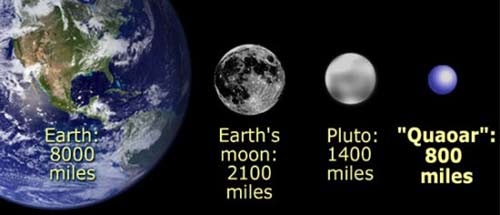|
The Hubble Space Telescope has measured the
diameter of a distant world more than half the size of Pluto.
by Ron Koczor
Astronomers have dubbed
it "Quaoar" (pronounced kwa-whar) after a Native American god. It
lies a billion kilometres beyond Pluto and moves around the Sun
every 288 years in a near-perfect circle. Until recently it was
just a curious point of light. That's all astronomers could see
when they discovered it last June 2002 using a ground-based telescope.
But now it's a world.
NASA's Hubble Space
Telescope has measured Quaoar and found it to be 1300 km wide. That's
about 400 km wider than the biggest main-belt asteroid (Ceres) and
more than half the diameter of Pluto itself. Indeed, it's the largest
object in the solar system seen since the discovery of Pluto 72
years ago.
Quaoar is greater in
volume than all known asteroids combined. Researchers suspect it's
made mostly of low-density ices mixed with rock, not unlike the
makeup of a comet. If so, Quaoar's mass is probably only one-third
that of the asteroid belt.
Michael Brown and Chadwick
Trujillo of the California Institute of Technology, Pasadena, California,
reported these findings at the 34th annual meeting of the Division
for Planetary Sciences of the American Astronomical Society in Birmingham,
Alabama in Oct 2002.

Quaoar's
size compared to that of Earth, Earth's moon and Pluto.
|
Earlier in 2002, Trujillo and Brown
had used the Palomar 48-inch telescope to discover Quaoar as an
18.5-magnitude object creeping across the summer constellation Ophiuchus.
Although Quaoar was relatively bright (by the feeble standards of
such distant objects) its disk was too small for the Palomar telescope
to resolve.
Brown followed-up their
discovery using the Hubble Space Telescope. Hubble's new Advanced
Camera for Surveys revealed the object's true angular size of 40
milliarc seconds, corresponding to a diameter of about 800 miles
(1300 kilometres). Only Hubble has the sharpness needed to actually
resolve the disk of such a distant world.
Like the planet Pluto,
Quaoar dwells in the Kuiper Belt, an icy debris field of comet-like
bodies extending 5 billion kilometres beyond Neptune's orbit. Over
the past decade more than 500 icy bodies - Kuiper-Belt Objects or
"KBOs" for short - have been found there. With a few exceptions
all have been significantly smaller than Pluto.

An artist's
concept of Quaoar.
|
Previous record holders are a KBO called
Varuna, and an object called 2002 AW197, each approximately 540
miles across (900 kilometres). Those diameters were deduced by measuring
the objects' temperatures and calculating a size based on assumptions
about the KBOs' reflectivity. Such estimates are less certain than
Hubble's direct measurements.
The name Quaoar has
now been voted on, and approved by The International Astronomical
Union (IAU). The body which makes the final decision on such matters.
Trujillo and Brown
suggested "Quaoar" after a creation god of the Native American Tongva
tribe - the original inhabitants of the Los Angeles basin where
Caltech is located. According to legend, Quaoar "came down from
heaven; and, after reducing chaos to order, laid out the world on
the back of seven giants. He then created the lower animals, and
then mankind."
Eventually, predicts
Brown, KBOs even larger than Quaoar will be found, and Hubble will
be invaluable for follow-up observations to pin down their sizes.
Meanwhile, Quaoar is the record-holder - a tantalizing glimpse of
perhaps bigger things to come.
Note:
Pluto is both a planet and a member of the Kuiper Belt. Quaoar is
merely a KBO. It's too small to merit automatic planethood. If you
ask a dozen astronomers how big something has to be to be called
a planet, you might get a dozen different answers. The definition
of planets is a topic of lively discussion and size is only one
factor. For now, the solar system has 9 planets. Quaoar is not the
10th. It is, nevertheless, an impressive and intriguing new world.
|
